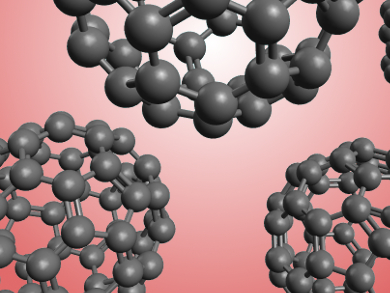Fullerenols
The fullerenes, those all-carbon spherical and spheroidal molecules we have dubbed buckyballs, were the darlings of many a chemistry laboratory not too many years into the past. Then they were usurped to some extent by their elongated cousins, the carbon nanotubes, and those in their own way were ousted by what is essentially their unrolled counterpart the two-dimensional grapheme. Of course, while science has always moved in mysterious ways with fields being ploughed and others left fallow, there are always lonely pockets in which old seeds are re-planted and new ideas grown.
It is not entirely surprising to learn that fullerene derivatives have held interest in some of those fertile fields and it seems that they may have an unexpected use in biology that was probably never dreamed of by their discoverers back in the 1990s. Chinese researchers have investigated the purportedly powerful antioxidant activity of polyhydroxyl fullerenes (the fullerenols), which are water-soluble fullerene derivatives. Many compounds that contain multiple hydroxyl units are known to be antioxidants. But Xiaolin Bi and colleagues, Chinese Academy of Sciences, Beijing, National Center for Nanoscience and Technology of China, Beijing, and Dalian Medical University, China, have investigated the anti-stress and anti-aging potential of fullerenol in the molecular biologist’s favourite nematode worm, Caenorhabditis elegans (C. elegans).
C. elegans is well known as a model organism against which many biomedical hypotheses can be tested in the certain knowledge that experimental results may well be extrapolated to other organisms, including Homo sapiens. As such, the team’s finding that fullerenol has no obvious toxic effects on the worms, does not interfere with their normal growth, but does seem to slow the aging process, might offer hope that this compound could be rolled out as an anti-aging agent for people in the future. Specifically, the team reports that: “fullerenol attenuates endogenous levels of reactive oxygen species and provides protection to C. elegans under stress conditions … and improving lifespan.”
Reducing Oxidative Stress
Oxidative stress caused by the ingestion or metabolic release of oxidizing agents, free radicals and other species in the body, is a cause of damage to cell components including DNA and proteins. The signs of aging – both external and internal – are associated to some extent with the oxidative damage of living our lives. The generation of such reactive oxygen species, particularly via mitochondrial respiration, leads to our bodies expressing stress-responsive proteins, which are key factors in determining how long an organism will live.
Too much oxidative stress and too little protective response is not a good recipe for a long and healthy life. It is inevitable that a whole industry exists to provide the worried well with antioxidant supplements. Of course, many of the reactive oxygen species are generated to help our immune systems attack invading microbes and other harmful entities, so it is a moot point as to whether or not supplementation is an entirely positive thing or whether a healthy diet rich in fruit and vegetables and low in sugars and fats is not a more sensible health regime to follow. Regardless, the search goes on unimpeded for agents of antioxidation that may well be useful in improving our health in old age, and indeed, helping to reduce the stress risks and so allowing us to enter that period of our lives in the first place.
Extending Lifespan by Up-Regulation of Genes
The administering of fullerenol to C. elegans up-regulates stress-related genes in what the team refers to as a DAF-16 dependant manner and so extends lifespan. DAF-16 is the master transcription factor in the regulation of longevity and an important target of insulin-linked biochemical pathways. DAF-16 regulates many genes that endow the organism with resistance to oxidative stress by triggering the expression of superoxide dismutase, heat-shock protein and metallothionein, for instance.
Whether or not fullerenol activity and life extension in C. elegans can be extrapolated to humans remains to be seen, but the team has certainly demonstrated an important tool in their chemical arsenal for investigating the biochemistry and the molecular biology of oxidative stress and so might be a useful technology for biomedical research in many ways before it bounces on to the supplement shelves of your local health food store.
Fullerene expert Rade Injac, who works in industry, explains that, “In general fullerene and fullerenols have dual action. In one of my investigations it was shown that strong antioxidant effect can be switch to strong cytotoxic effect as well.” He adds that, the fullerenols specifically are able to react differently in different environments. “I would support the theory of anti-stress and anti-ageing but with limitations,” he told ChemViews Magazine.
- Evaluation of the influence of fullerenol on aging and stress resistance using Caenorhabditis elegans,
Wenshu Cong, Peng Wang, Ying Qu, Jinglong Tang, Ru Bai, Yuliang Zhao, Chunying Chen, Xiaolin Bia,
Biomaterials 2015, 42, 78–86.
DOI: 10.1016/j.biomaterials.2014.11.048




